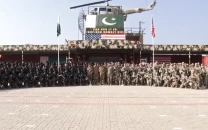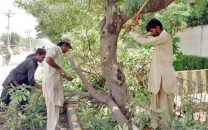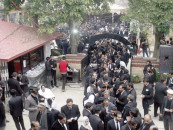The road to Swat: What hatred destroyed, humanity has tried to rebuild
'Occasions of hatred are certainly never settled by hatred but by freedom from hatred - Buddha.

Over the years, this road has carried much more than travellers wishing to escape the oppressive heat of the plains. It has seen the movement of men who have wanted to vanquish the valley as much as conquer the people.
But this time, it was not with the message of peace, acceptance and detachment preached by Buddhist monks traversing the high mountain passes and settling into monasteries for the rainy season, reaffirming their commitment to the dharma of their spiritual master, the Lord Buddha.
That was two thousand years ago, when the valley was known as Uddiyana, or “Royal Garden”, in Sanskrit.
In the 1920s, the intrepid scholar, researcher, archaeologist and traveller Sir Aurel Stein wrote about this splendid kingdom: “With cascading pure rivers splashing down from ice-bound lakes high in the snowy peaks beyond, and quiet pools stocked with fish, with lush meadows, in raiment of every variety of wildflower, Uddiyana truly seemed a paradise on earth. No wonder people from far and wide spoke of it as a magical place, the hidden flower garden of the wise and compassionate Lord Buddha”.
Today, the landscape is largely scarred by unplanned development, ugly structures rising out of the earth where the remains of ancient cities lie waiting to be explored, their secrets buried beneath the detritus of history.
The trees in the inhabited areas have been felled, making way for yet more housing, and piles of garbage litter the streets as hungry dogs rummage through it for sustenance.
As we drive along the road from Batkhela to Landakai then Barikot, the ancient “Bazira” of Greek times, the road becomes an artery leading to the heart of the valley. Hundreds, if not thousands, of stupas, monasteries, viharas, forts, rock inscriptions, paintings and etchings and stelae marked the landscape of ancient Uddiyana.
Over the years, many sites have been vandalised, looted for the treasures that lie within: sculptures of Buddha, his form as the Future Buddha or Bodhisatva, the Hindu deities of Ganesha and Shiva, and the life stories or jatakas of Buddha which must have decorated the base of the stupa and the stairs leading up to the area for circumambulation.
Those antiquities which escaped the avarice of the smugglers fall prey to the ignorance of the wayfarers who pelt stones at the images of idols long forgotten by even their worshippers. Only the notion of intolerance and hatred prevails, convincing the “believer” in the “unbelief” of the other.
At Ghalegai, across from the gently undulating River Swat, the Suvastu of ancient times, a Neolithic era rock shelter gives testimony to the fact that the valley was inhabited at least 3,000 years ago. Potsherds and stone implements littered this shelter, helping to date it to the 4th millennium BC. Just below it is the majestic seated “dhyani” or meditating Buddha.
Above the relief is a small cave, known as “Hindu Ghar”, accessible from the road by climbing a flight of 60 steps. Here we find a defaced bearded and haloed Surya figure standing on a pedestal supported by six lions and flanked by two figures on the right and three on the left.
The Surya figure, dating to the Turki Shahi period (7th century CE), wears a Kushana costume similar to the robes worn by Kanishka who ruled the valley in the second century of the historic period, bringing the region to a peak of prosperity before it was conquered by Sassanian rulers of Iran in 241 AD.
We continue on the road past Manyar and Tindodag towards Udegram, a site rich with history and irony. I am told by my guide and driver that recent excavation, assisted by MPhil students from the University of Hazara, has led to the finding of two pre-historic graves with skeletons and grave pottery intact.
It is here that Sultan Mahmood of Ghazni had a mosque built, possibly on the foundations of a Buddhist monastery. Discovered in 1985 by Italian scholar Umberto Scerrato, the mosque is still used to offer prayers.
Once the area was cleared of militants by the Pakistan Army, a cemented access path and a culvert bridge was laid by the army in order for visitors to explore this ancient place of worship.
High above the 10th century mosque, the third oldest in the country, I spot the outlines of the remains of the fort of the Hindu raja Gira.
Viewing the landscape from a distance gives one a sense of infinity: the infinite ways in which human beings have worshipped the divine, infinite possibilities of living in harmony with other faiths which essentially answer the same questions which have plagued humankind for an eternity: who are we, why are we here, who created us, what happens when we die?
I climb through a small orchard of peach trees and find myself staring at the ossified skeletal remains of a person who lived and died on the same ground upon which I now stood.
That this elderly man, whose bones were buried with those of a young child, knew the same mountains, drank from the stream below and harvested the fruit which grew in abundant orchards, only reaffirmed my belief that essentially we are the same.
We are both born of clay and dust, returned to the earth to return again and again, living the space between birth and death.
I stared at the beautifully turned grave pottery which lay in clusters around the skeleton and wondered at the hands which fashioned them, the songs that must have been sung as earth mixed with water and morphed into a vessel, the fabric which must have clothed the potter, the dreams that the child dreamt before being laid out on the stone slab which cradled her for several thousand years.
According to the Italian and Pakistani experts working there, the pottery suggests a period between the second and first millennium before the Common Era (BCE).
Who presided over the funeral and the rituals which denoted that there was a life after death? What were the words that were spoken to the mother of the child, the wife of the dead man, his children, to console them for their loss? Was it a celebration or was it a tragedy?
Who were these people who arranged their dead in precise rows, providing them with sustenance for the journey ahead, covering them with large megalithic slabs which have kept their secret for millennia?
I want to stay in Udegram for a life time, but I must move on for the road awaits me and beckons. I still have to travel past the towns of Balogram and Fizaghat which saw fierce fighting between the militants and the local people before the military stepped in several long, bloody and unexplained years later.
Here, scarred carcasses of houses, factories, schools and bridges stand testimony to that terrible time when forces inspired by the manipulative sermons of Mullah Fazlullah unleashed their hatred for everything that Swat had been for hundreds of years: a haven for peaceful worship, for spiritual as well as progressive education, for its countless orchards of fruit, for its undulating river, its gentle slopes dotted with terraces where crops grew to feed its many communities: Pakhtun, Torwal, Ushugu, Gujjar, Kohistani, among others.
I am on my way to the hamlet of Jahanabad, a short distance from Manglaur where a modern Institute of Tourism and Hotel Management built by the Austrians lies abandoned after having been destroyed by the militants.
The Pakistan Army now occupies the shelled out campus, and young military officers based in Jahanabad entertain me with kindness, conversation, and a cup of tea before I begin my climb up the steep mountain.
From there, I am to gaze at the haunting beauty of the huge rock relief of Lord Buddha which graces the surface of a magnificent outcrop of massive boulders piled up on top of each other, lined with the dark stains of water and time. It is here that I am to spend the next fifteen days, documenting the conservation process being carried out.
It is a long climb up through a thick fruit orchard supported by an ancient stone wall. I stand still to listen to the solitude; birds call and crickets sing a silent song.
Somewhere a child calls out, a dog answers, an ethereal tranquility descends like a mist and envelops me.
There is something here I cannot see or feel or touch — there is something which tells me that this was a place of great reverence, where prayers were chanted, were human desire was subsumed in the belief that to exist is to suffer, that the end of suffering begins with the death of desire.
I do not want to shake off this sense of another time which draws me into it with a gentle pull, whispering secrets of the past, waiting to be heard, to be understood and cherished.
I turn away with profound reluctance. There is a task that lies ahead and soon the sun will be setting, plunging the valley into darkness.
The path veers upwards towards a tiny settlement where the dog and child greet me as if I was one of their own. I speak in halting Pushto and ask them how much further to the carving of the Buddha.
The boy takes my hand and points in the direction of the massive outcrop at the top of the mountain.
“That one, there?” he asks? “That buth which the kafirs carved?”
I look at this child, all of seven or eight years old, his shoes too big for him, his shirt too small, face smeared with grime, a mischievous grin despite all that was missing. He tugs at the rope that he has tied around the dog’s neck and begins to lead me over the narrow path, scattering the few chickens that peck at the ground.
“Come,” he says, “I [will] take you to see this buth which does not have a face, this kafir buth.”
The bas-relief of Lord Buddha was probably carved in the sixth or seventh century of the Common Era. Buddha sits on a pedestal or astana, his legs folded under him and his hands resting in his lap, a sense of peace and quietness enveloped in the folds of his garment.
ndeed, he does not have a face, most of it having been blown away by militants fighting a war in which the only victor is death. All that remains of the face is one ear and his mouth, curved along the edges in a tender smile, indifferent to the depth of the hatred and violence which tried to destroy it.
In 2007, at the height of the violence perpetrated by extremists, at least 50 men and women were executed in the now reclaimed Green Chowk, then renamed as Khooni or Bloody Chowk, situated in the middle of the bustling bazaar of Mingora.
Barbers who dared to shave beards, CD shop owners who dared to sell music, women who dared to sing and dance, ordinary people who dared to live a life free of fear — all became the targets of the bitter venom spewed by the hydra-headed monster which is intent on consuming the last vestiges of harmony and beauty in this beloved, blighted land.
The same monster which tried to claim the life of a brave little girl named Malala, whose name itself mean ‘grief-stricken’. While the lust for blood was being quenched by public executions, the beatific splendour of the Buddha rock relief in Jahanabad became yet another target.
“We don’t know who did it,” a young man standing beneath the thirty-metre-high relief tells me. He does not look at the relief or at me, perhaps out of deference for my female status in a conservative culture where men are taught not to look at women who are not “theirs”.
Who drilled the holes in the shoulders of the Buddha relief, and one on the top of the ushnisha, the knot of hair worn instead of a crown by Gautama Siddharta, Prince of Lumbini, Buddha? Explosives were packed into the holes and then detonated, apparently after the rocket that was launched from across the River Swat failed to destroy its target.
“They came in the middle of the night, it was dark, we did not see them…,” the young man continues before looking away at the haze hovering above the river.
I do not disturb the silence between us and join him in his reverie, staring at the horizon interrupted here and there with lush green terraces and the pink blossoms of apricot trees.
Amidst all this beauty a heinous crime had been committed, a crime against humanity and beauty and the diversity of the human experience. And today that violent act was going to be addressed by men who held in his hands the magic of healing, the warmth of human will.
The team was led by a foreigner, whose name and nationality cannot be mentioned for fear that he and his team may also become targets. Suffice it to say that he is a restorer and conservator of ancient heritage, having previously worked on restoring the murals surrounding the colossal Buddhas of Bamiyan.
Watching him climb the 30-metre-high scaffolding erected by local carpenters, it was clear that he was used to working in difficult circumstances. Having gathered the initial data on an earlier trip, he was now engaged in cleaning the entire surface of the rock relief, removing organic growth as well as dust and the remains of explosive powders.
The attacks on the relief separated the upper part of the face from the wall under study and resulted in the loss of constituent material.
The explosion also created fractures and micro-fractures in the wall, and weakened the surface in areas directly adjacent to the resulting gaps. His task was to repair the cracks and fissures and to ensure that further deterioration of the surface did not take place, possibly resulting in the loss of the entire face.
The presence of lichens and micro-organisms was also of great concern since their activity could also cause further impoverishment of the surface.
After cleaning the entire surface using soft brushes, he treated the relief with a resin and secured the areas in danger of collapsing.
Assisted by two local men, he then grouted the cracks and fissures and began the filling on the tenth day of the conservation process.
Two cameramen shot the entire process while a third camera was placed at strategic positions to record the entire process in time lapse mode, capturing the changing light and the movement of the clouds as they floated across the vast sky, witnessing an act of love and healing.
I watched this process in awe, grateful for the opportunity to be so close to perhaps the first effort to conserve a casualty of war which, though it did not bleed, was grievously hurt nonetheless. Watching him place his syringe full of resin in the fissures and cracks was like watching a doctor inject a sick child.
When he placed gauze strips along large cracks before he grouted the gaps, it appeared as if he was bandaging an injured limb.
And finally, when the volumes of the missing part were filled with a slightly chromatically distinguishable mixture of plaster and micro-gravel, it seemed as if life was emerging out of a deep tomb where an invincible spirit lay buried.
It is the fifteenth day today. The team members are seated on the boulders which rest beneath the relief, allowing them to gaze up at this magnificent feat, a testimony to the belief in peace and harmony and the resilience of the human spirit.
The lead restorer slides off the boulder and walks away with his camera, striding through the undergrowth. I watch as he disappears into the lush foliage, remembering his words: “Calm, serenity, power, thirst, contentment ... this is how I feel when I finish a restoration job, anywhere in the world.
I feel the blood coursing through my veins, but this time, with that light, the emotion was stronger: you love the world, but at the same time you are sad, very sad, because you realise that such a moment will never come again and just this aspect makes it extraordinary.
Then you turn, you walk with your back to the work, but for days, weeks, sometimes after years and almost always those images dance in front your eyes … something indescribable has settled in you, something that makes you sigh, the sighs of a lover.”
Behind the three men, the River Suvastu flows gently, meandering through fertile fields which give forth their bounty to a people hungry for sustenance and dignity.
The sun begins to set, casting its golden light on the relief, almost as if the universe too, and its planets and all that lived within it, wanted to celebrate the challenge that had been met; a challenge which must be met if our past is to show us a path to a future where all beings live with a sense of serenity and love, not fear and hatred.
Published in The Express Tribune, Sunday Magazine, October 21st, 2012.
Like Express Tribune Magazine on Facebook and follow at @ETribuneMag



















COMMENTS
Comments are moderated and generally will be posted if they are on-topic and not abusive.
For more information, please see our Comments FAQ